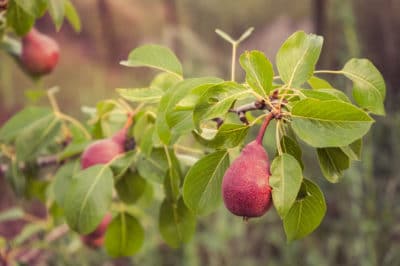Harvesting
Why not just let your pears ripen on the tree the way nature intended? Pears naturally ripen from the inside out. If you wait to pick them until the outside is soft and ripe, the inside will be mushy and past its peak. Have you ever eaten a pear from a tree and got a mouthful of mealy mush? That’s a tree-ripened pear.
It’s important to distinguish between maturity and ripeness. Pears should reach maturity on the tree. This means that they have grown to their final size and will not get bigger. There is a window between when a pear is mature yet still green and that’s when you harvest.
Mature pears may still be green and hard to the touch. How do you know when to pick them? There is one technique all orchardists know, it’s called the tilt test. Take a pear that hangs vertically off the tree and tilt it until it is horizontal. This puts slight pressure on the stem as it gets twisted. A mature pear that is ready for harvest will detach easily when tilted. Bosc pears are the exception to this rule. They are known for clinging to the tree.
Ripening
Pears will usually ripen in five to seven days once picked. Spread them out on the kitchen counter or use a tarp if you’ve got a large harvest. Avoid leaving them in the hot sun which can potentially damage fruits. As pears ripen they will change color. Depending on the varieties grown, some may turn brown, yellow, red, or exhibit red blushes.
Nothing ripens a pear more perfectly than patience. If you want to speed things up, there is a tried and true way. Place the pears in a paper bag and they will ripen within three days. If you add a banana or an apple to the bag, they can ripen in one to two days. Keep in mind the banana releases ethylene gas and ripens the pears from the inside out just like they would on the tree.
Ripening them too fast causes them to go mushy on the inside. The best method is to stay out of it and let time take its course.
Peak Ripeness
Color is not the only factor in determining whether a pear is ripe. Choose fruits at the market or grocery that are still slightly green to give yourself some time to use them.
Biting into an unripe pear can be disappointing. Check for ripeness before slicing them into your oatmeal. Here is a checklist for determining if pears a ripe.
- Color – It should be fully colored out, no hints of green unless it is a green variety.
- Smell – A ripe pear smells sweet and strong, not green or flavorless.
- Check the neck – If the flesh around the neck of the pear gives with slight pressure, it is ripe.
Asian Pears
Asian pears are different from European pears. Sometimes called apple-pears, Japanese pears, or Nashi pears, these fruits taste like pears but have a shape and texture much like apples. Like European pears, Asian pears have a wide harvest season. Depending on the variety grown harvests may take place from July to October. Knowing your variety of Asian pear helps you determine when it will ripen.
Asian pears ripen to perfection right on the tree. There’s no need to pick them green and ripen them on the counter. That method will work in emergency situations if there is a freeze or hail storm coming, but it isn’t as desirable as a tree-ripened Asian pear.
The skin of a ripe Asian pear is a creamy brown color with slightly risen white dots. Brown dots are indicators of bruising or over-ripeness. If a pear has six or more brown spots, it may be too far gone for fresh eating.
Smell the pear for sweetness and a floral scent. Ripe pears will smell sweet and strong. Hardness is not a good indicator of ripeness in Asian pears because they are naturally hard. Instead of the flesh giving like a European pear, Asian pears should spring back slightly. When ripe the texture is somewhere between a European pear and an apple.
